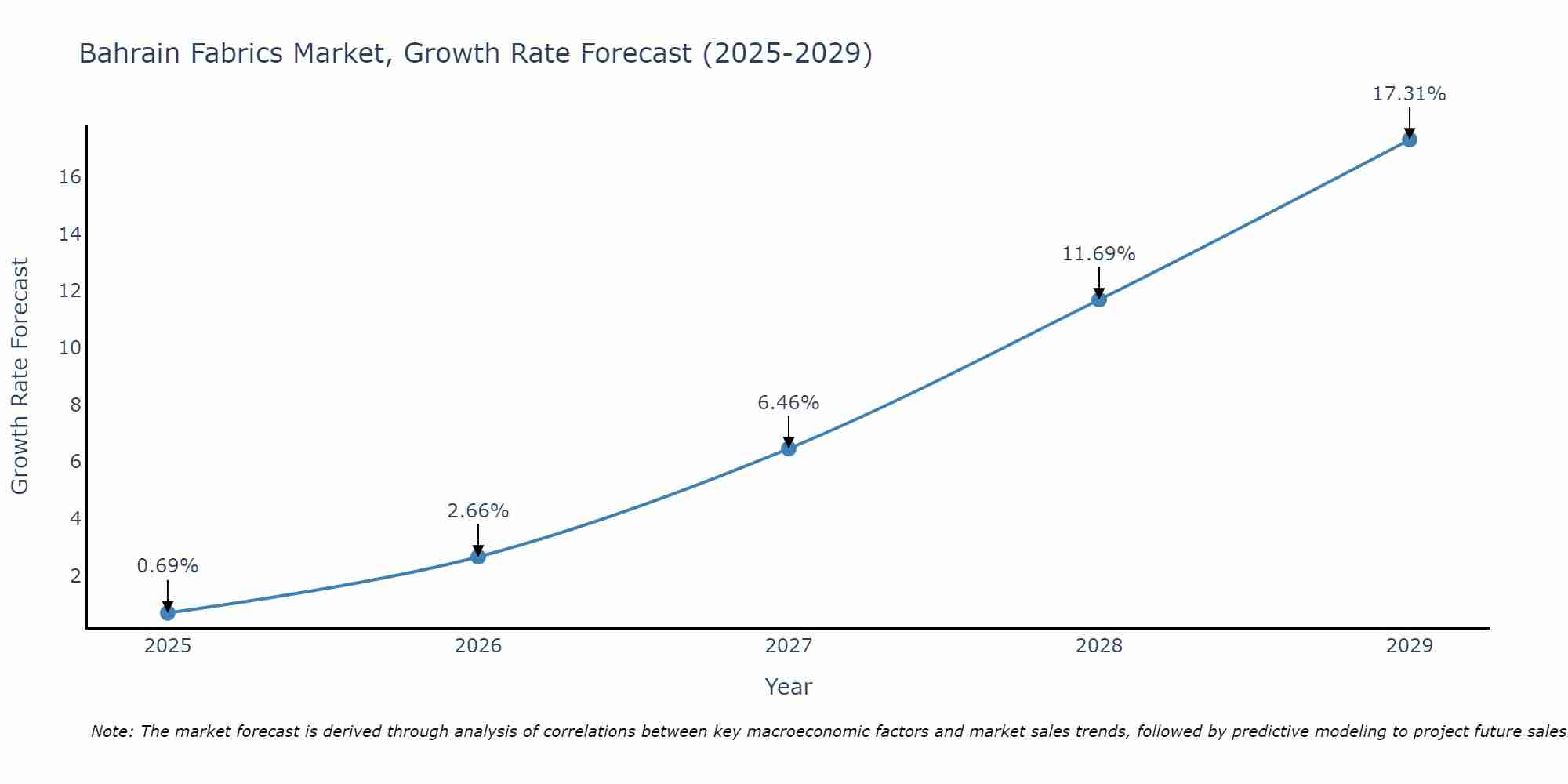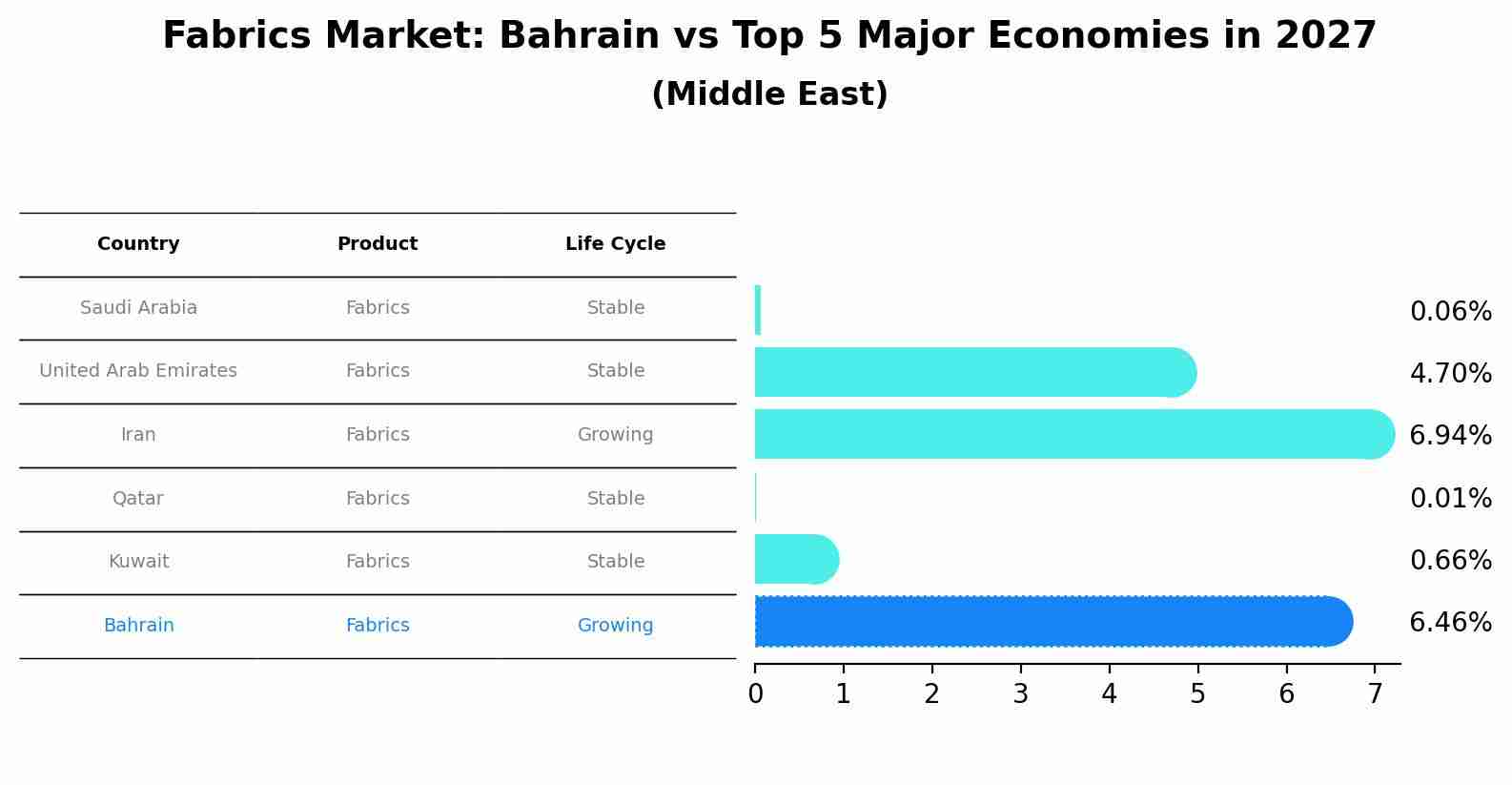Bahrain Fabrics Market (2025-2031) | Outlook, Trends, Size, Companies, Value, Industry, Analysis, Growth, Revenue, Share & Forecast
| Product Code: ETC023644 | Publication Date: Oct 2020 | Updated Date: Apr 2025 | Product Type: Report | |
| Publisher: 6Wresearch | Author: Ravi Bhandari | No. of Pages: 70 | No. of Figures: 35 | No. of Tables: 5 |
Bahrain Fabrics Market Size Growth Rate
The Bahrain Fabrics Market is likely to experience consistent growth rate gains over the period 2025 to 2029. From 0.69% in 2025, the growth rate steadily ascends to 17.31% in 2029.

Fabrics Market: Bahrain vs Top 5 Major Economies in 2027 (Middle East)
The Fabrics market in Bahrain is projected to grow at a growing growth rate of 6.46% by 2027, within the Middle East region led by Saudi Arabia, along with other countries like United Arab Emirates, Iran, Qatar and Kuwait, collectively shaping a dynamic and evolving market environment driven by innovation and increasing adoption of emerging technologies.

Bahrain Fabrics Market Overview
The fabrics market in Bahrain is seeing growth driven by the demand from the apparel and home textiles sectors. Consumers are increasingly opting for sustainable, organic, and high-quality fabrics, while the fashion industry is evolving with fast fashion and customized clothing trends. The demand for diverse fabric types, including cotton, polyester, and blends, is shaping the market`s dynamics.
Drivers of the market
The fabrics market in Bahrain is growing steadily, supported by the increasing demand for textiles in the fashion, home décor, and industrial sectors. Bahrains fashion industry is experiencing growth as consumers seek high-quality and unique fabrics for clothing. In addition, the construction and real estate boom is driving demand for fabrics used in interior design, such as curtains, upholstery, and bed linens. Technological advancements in fabric production, including the development of smart fabrics and eco-friendly textiles, are shaping the market. The growing awareness of sustainable fashion is also encouraging consumers and manufacturers to opt for organic and recycled fabrics.
Challenges of the market
The fabrics market in Bahrain is challenged by the growing demand for sustainable and eco-friendly textiles, as consumers become more conscious of the environmental impact of fabric production. Manufacturers must invest in organic materials, such as cotton and linen, as well as sustainable production processes, which increases costs. Additionally, the market is highly competitive, with international suppliers offering a wide range of high-quality fabrics at competitive prices. The volatility of global raw material prices, particularly for cotton and synthetic fibers, impacts the profitability of local manufacturers. Compliance with international textile safety and environmental standards adds further complexity to market operations.
Investment opportunities in the Market
The fabrics market in Bahrain presents investment potential driven by demand from the fashion, interior design, and automotive sectors. Investors can explore opportunities in producing or importing a variety of fabrics, including cotton, synthetic, and technical textiles, that meet industry-specific requirements. With growing consumer interest in sustainable and high-performance textiles, there is potential for developing eco-friendly and innovative fabric solutions.
Government Policy of the market
The fabrics market in Bahrain is shaped by government policies that regulate textile imports and encourage the growth of local textile industries. The government promotes the use of sustainable and high-quality fabrics in various sectors, including fashion, home décor, and industrial applications. Trade policies facilitate the import of raw materials, while local manufacturers benefit from initiatives aimed at boosting the textile and garment industries. The growing demand for premium fabrics, driven by consumer preferences for quality and sustainability, has contributed to market growth.
Key Highlights of the Report:
- Bahrain Fabrics Market Outlook
- Market Size of Bahrain Fabrics Market, 2024
- Forecast of Bahrain Fabrics Market, 2031
- Historical Data and Forecast of Bahrain Fabrics Revenues & Volume for the Period 2021 - 2031
- Bahrain Fabrics Market Trend Evolution
- Bahrain Fabrics Market Drivers and Challenges
- Bahrain Fabrics Price Trends
- Bahrain Fabrics Porter's Five Forces
- Bahrain Fabrics Industry Life Cycle
- Historical Data and Forecast of Bahrain Fabrics Market Revenues & Volume By Types for the Period 2021 - 2031
- Historical Data and Forecast of Bahrain Fabrics Market Revenues & Volume By Manmade And Special Fiber Fabrics for the Period 2021 - 2031
- Historical Data and Forecast of Bahrain Fabrics Market Revenues & Volume By Knitted Fabrics for the Period 2021 - 2031
- Historical Data and Forecast of Bahrain Fabrics Market Revenues & Volume By Cotton for the Period 2021 - 2031
- Historical Data and Forecast of Bahrain Fabrics Market Revenues & Volume By Non-Cotton for the Period 2021 - 2031
- Historical Data and Forecast of Bahrain Fabrics Market Revenues & Volume By Distribution Channel for the Period 2021 - 2031
- Historical Data and Forecast of Bahrain Fabrics Market Revenues & Volume By Direct for the Period 2021 - 2031
- Historical Data and Forecast of Bahrain Fabrics Market Revenues & Volume By Indirect for the Period 2021 - 2031
- Historical Data and Forecast of Bahrain Fabrics Market Revenues & Volume By Hypermarket/Supermarket for the Period 2021 - 2031
- Historical Data and Forecast of Bahrain Fabrics Market Revenues & Volume By Specialty Stores for the Period 2021 - 2031
- Historical Data and Forecast of Bahrain Fabrics Market Revenues & Volume By Online Store for the Period 2021 - 2031
- Bahrain Fabrics Import Export Trade Statistics
- Market Opportunity Assessment By Types
- Market Opportunity Assessment By Distribution Channel
- Bahrain Fabrics Top Companies Market Share
- Bahrain Fabrics Competitive Benchmarking By Technical and Operational Parameters
- Bahrain Fabrics Company Profiles
- Bahrain Fabrics Key Strategic Recommendations
Frequently Asked Questions About the Market Study (FAQs):
1 Executive Summary |
2 Introduction |
2.1 Key Highlights of the Report |
2.2 Report Description |
2.3 Market Scope & Segmentation |
2.4 Research Methodology |
2.5 Assumptions |
3 Bahrain Fabrics Market Overview |
3.1 Bahrain Country Macro Economic Indicators |
3.2 Bahrain Fabrics Market Revenues & Volume, 2021 & 2031F |
3.3 Bahrain Fabrics Market - Industry Life Cycle |
3.4 Bahrain Fabrics Market - Porter's Five Forces |
3.5 Bahrain Fabrics Market Revenues & Volume Share, By Types, 2021 & 2031F |
3.6 Bahrain Fabrics Market Revenues & Volume Share, By Distribution Channel, 2021 & 2031F |
4 Bahrain Fabrics Market Dynamics |
4.1 Impact Analysis |
4.2 Market Drivers |
4.3 Market Restraints |
5 Bahrain Fabrics Market Trends |
6 Bahrain Fabrics Market, By Types |
6.1 Bahrain Fabrics Market, By Types |
6.1.1 Overview and Analysis |
6.1.2 Bahrain Fabrics Market Revenues & Volume, By Types, 2021 - 2031F |
6.1.3 Bahrain Fabrics Market Revenues & Volume, By Manmade And Special Fiber Fabrics, 2021 - 2031F |
6.1.4 Bahrain Fabrics Market Revenues & Volume, By Knitted Fabrics, 2021 - 2031F |
6.1.5 Bahrain Fabrics Market Revenues & Volume, By Cotton, 2021 - 2031F |
6.1.6 Bahrain Fabrics Market Revenues & Volume, By Non-Cotton, 2021 - 2031F |
6.2 Bahrain Fabrics Market, By Distribution Channel |
6.2.1 Overview and Analysis |
6.2.2 Bahrain Fabrics Market Revenues & Volume, By Direct, 2021 - 2031F |
6.2.3 Bahrain Fabrics Market Revenues & Volume, By Indirect, 2021 - 2031F |
6.2.4 Bahrain Fabrics Market Revenues & Volume, By Hypermarket/Supermarket, 2021 - 2031F |
6.2.5 Bahrain Fabrics Market Revenues & Volume, By Specialty Stores, 2021 - 2031F |
6.2.6 Bahrain Fabrics Market Revenues & Volume, By Online Store, 2021 - 2031F |
7 Bahrain Fabrics Market Import-Export Trade Statistics |
7.1 Bahrain Fabrics Market Export to Major Countries |
7.2 Bahrain Fabrics Market Imports from Major Countries |
8 Bahrain Fabrics Market Key Performance Indicators |
9 Bahrain Fabrics Market - Opportunity Assessment |
9.1 Bahrain Fabrics Market Opportunity Assessment, By Types, 2021 & 2031F |
9.2 Bahrain Fabrics Market Opportunity Assessment, By Distribution Channel, 2021 & 2031F |
10 Bahrain Fabrics Market - Competitive Landscape |
10.1 Bahrain Fabrics Market Revenue Share, By Companies, 2024 |
10.2 Bahrain Fabrics Market Competitive Benchmarking, By Operating and Technical Parameters |
11 Company Profiles |
12 Recommendations |
13 Disclaimer |
- Single User License$ 1,995
- Department License$ 2,400
- Site License$ 3,120
- Global License$ 3,795
Search
Thought Leadership and Analyst Meet
Our Clients
Related Reports
- Afghanistan Apparel Market (2026-2032) | Growth, Outlook, Industry, Segmentation, Forecast, Size, Companies, Trends, Value, Share, Analysis & Revenue
- Canada Oil and Gas Market (2026-2032) | Share, Segmentation, Value, Industry, Trends, Forecast, Analysis, Size & Revenue, Growth, Competitive Landscape, Outlook, Companies
- Germany Breakfast Food Market (2026-2032) | Industry, Share, Growth, Size, Companies, Value, Analysis, Revenue, Trends, Forecast & Outlook
- Australia Briquette Market (2025-2031) | Growth, Size, Revenue, Forecast, Analysis, Trends, Value, Share, Industry & Companies
- Vietnam System Integrator Market (2025-2031) | Size, Companies, Analysis, Industry, Value, Forecast, Growth, Trends, Revenue & Share
- ASEAN and Thailand Brain Health Supplements Market (2025-2031) | Strategy, Consumer Insights, Analysis, Investment Trends, Opportunities, Growth, Size, Share, Industry, Revenue, Segments, Value, Segmentation, Supply, Forecast, Restraints, Outlook, Competition, Drivers, Trends, Demand, Pricing Analysis, Competitive, Strategic Insights, Companies, Challenges
- ASEAN Bearings Market (2025-2031) | Strategy, Consumer Insights, Analysis, Investment Trends, Opportunities, Growth, Size, Share, Industry, Revenue, Segments, Value, Segmentation, Supply, Forecast, Restraints, Outlook, Competition, Drivers, Trends, Demand, Pricing Analysis, Competitive, Strategic Insights, Companies, Challenges
- Europe Flooring Market (2025-2031) | Outlook, Share, Industry, Trends, Forecast, Companies, Revenue, Size, Analysis, Growth & Value
- Saudi Arabia Manlift Market (2025-2031) | Outlook, Size, Growth, Trends, Companies, Industry, Revenue, Value, Share, Forecast & Analysis
- Uganda Excavator, Crane, and Wheel Loaders Market (2025-2031) | Strategy, Consumer Insights, Analysis, Investment Trends, Opportunities, Growth, Size, Share, Industry, Revenue, Segments, Value, Segmentation, Supply, Forecast, Restraints, Outlook, Competition, Drivers, Trends, Demand, Pricing Analysis, Competitive, Strategic Insights, Companies, Challenges
Industry Events and Analyst Meet
Whitepaper
- Middle East & Africa Commercial Security Market Click here to view more.
- Middle East & Africa Fire Safety Systems & Equipment Market Click here to view more.
- GCC Drone Market Click here to view more.
- Middle East Lighting Fixture Market Click here to view more.
- GCC Physical & Perimeter Security Market Click here to view more.
6WResearch In News
- Doha a strategic location for EV manufacturing hub: IPA Qatar
- Demand for luxury TVs surging in the GCC, says Samsung
- Empowering Growth: The Thriving Journey of Bangladesh’s Cable Industry
- Demand for luxury TVs surging in the GCC, says Samsung
- Video call with a traditional healer? Once unthinkable, it’s now common in South Africa
- Intelligent Buildings To Smooth GCC’s Path To Net Zero


















